

Curator’s Workbench at Carolina Digital Repository Blog. Archive for the ‘Curator’s Workbench’ tag Curator’s Workbench 4.1.0 Fixes Mac Issues I’d like to extend a special thanks to those that helped us diagnose and resolve several issues on the Mac OS.
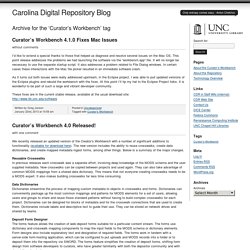
This point release addresses the problems we had launching the software via the “workbench.app” file. It will no longer be necessary to use the separate startup script. It also addresses a problem related to File Dialog windows. SourceForge - Download, Develop and Publish Free Open Source Software. JHOVE download. Open-source digital preservation system. The Half-Empty Archive. Cliff Lynch invited me to give one of UC Berkeley iSchool's "Information Access Seminars" entitled The Half-Empty Archive.
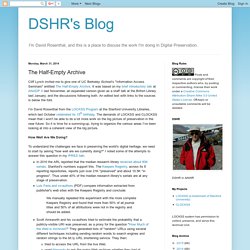
It was based on my brief introductory talk at ANADP II last November, an expanded version given as a staff talk at the British Library last January, and the discussions following both. An edited text with links to the sources is below the fold. Repositories. Trustworthiness: Self-assessment of an Institutional Repository against ISO 16363-2012. D-Lib Magazine March/April 2015 Volume 21, Number 3/4Table of Contents Trustworthiness: Self-assessment of an Institutional Repository against ISO 16363-2012 Bernadette Houghton Deakin University, Geelong, Australia bernadette.houghton@deakin.edu.au DOI: 10.1045/march2015-houghton Printer-friendly Version Abstract Today, almost every document we create and the output from almost every research-related project, is a digital object.
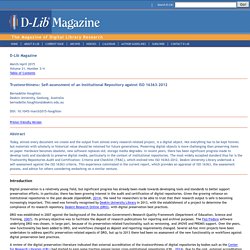
Introduction Digital preservation is a relatively young field, but significant progress has already been made towards developing tools and standards to better support preservation efforts. DRO was established in 2007 against the background of the Australian Government's Research Quality Framework (Department of Education, Science and Training, 2007). Toward Distributed Infrastructures for Digital Preservation: The Roles of Collaboration and Trust.
Toward Distributed Infrastructures for Digital Preservation: The Roles of Collaboration and Trust Michael Day.
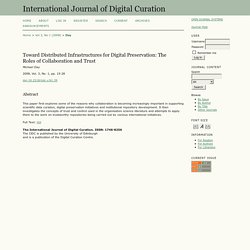
Archivematica 1.0 Screencast. Selecting file formats.
Digital Curation Resource Guide. Nrnt digital curation17mar11. Digital Libraries: A Vision for the 21st Century: A Festschrift in Honor of Wendy Lougee on the Occasion of her Departure from the University of Michigan. Anne R.
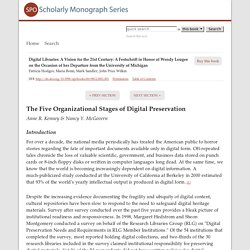
Kenney & Nancy Y. McGovern Introduction For over a decade, the national media periodically has treated the American public to horror stories regarding the fate of important documents available only in digital form. Oft-repeated tales chronicle the loss of valuable scientific, government, and business data stored on punch cards or 8-inch floppy disks or written in computer languages long dead. Despite the increasing evidence documenting the fragility and ubiquity of digital content, cultural repositories have been slow to respond to the need to safeguard digital heritage materials. These findings are consistent with a second survey conducted by the Digital Library Federation (DLF) in early 2001.
Cultural repositories below the research university level reveal even less institutional readiness. Of all the preservation challenges facing us, none is more pressing than developing workable solutions to digital preservation. A recent study by Daniel Greenstein and Suzanne E. When I Go Away: Getting Your Digital Affairs in Order. Nowadays when we prepare a will, we have the added responsibility of leaving instructions to our loved ones about what to do with our online things after we die.

Bequeathing has grown more complicated. Featured Last Will and Testament on Audiblewisdom.org Much of our online content consists of our writings – email, text, tweets, blogs, wikis and more – and our loved ones would surely cherish some of it just as surely as we cherish special old cards and letters. The same goes for our online photos, videos, artwork and other things we’ve created. All of this content exists in a situation unique to the digital age: it resides in cyberspace and, as such, some of it will continue to reside there long after we die while some of it will get deleted by their hosts after a period of time.
The first step is to inventory everything about your online life, such as your email accounts, Facebook, Twitter…everything. There and Back Again: Scoping a Web Archiving Project Around the Hobbit. The following is a guest post from Sarah Weissman, a second year student in the MLS program at University of Maryland’s iSchool.
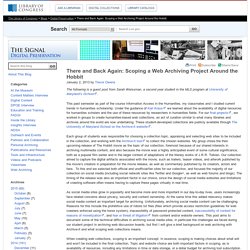
This past semester as part of the course Information Access in the Humanities, my classmates and I studied current trends in humanities scholarship. Under the guidance of Kari Kraus we learned about the availability of digital resources for humanities scholars and the use of these resources by researchers in humanities fields. Wepreserve. Wepreserve. Table of Contents. About the DCC. Many research teams are aware of data curation and its numerous benefits, but few have so far managed to address the issues practically and effectively in a working environment.
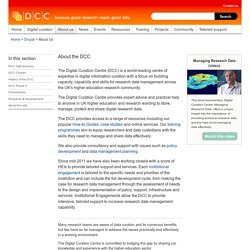
The Digital Curation Centre is committed to bridging this gap by sharing our knowledge and experience with the higher education sector. To do this, the DCC has embarked upon a fresh, new, three-year programme of work, which began in March 2010. Our help isn’t just limited to expert advice. We are a gateway to the technical solutions, curation tools and learning resources that can help data custodians like you to build capacity for digital curation.
Digital Curation for Science, Digital Libraries, and Individuals. Digital Curation for Science, Digital Libraries, and Individuals.
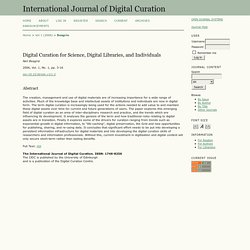
Association for Library Collections & Technical Services (ALCTS) ALA Annual Conference, Washington, D.C., June 24, 2007 Preamble These definitions have been developed to promote an understanding of digital preservation within the library community, as well as our allied professions and the user communities we exist to serve.
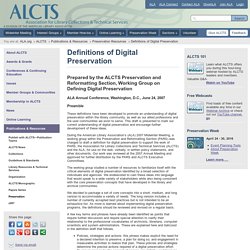
This draft is presented to mark our current understanding of digital preservation and encourage further development of these ideas.